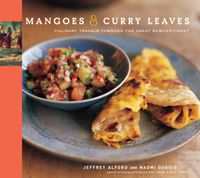Advertisement
Mustard
By Jeffrey Alford and Naomi Duguid
Published 2005
There are a number of varieties of mustard plants (Brassica, including B. juncea), most of them with intensely yellow flowers (see the photograph). They are eaten as greens; the seeds of some varieties are pressed for oil and also used as a spice. The name for mustard greens in much of the northern part of the Subcontinent is sarson. As in China, mustard greens are cooked and eaten like other leafy greens in the Subcontinent. They are sold in Asian grocery stores, specialty-produce and farmers’ markets, and in some large supermarkets. Mustard seeds are small and round. Different varieties of mustard have seeds of different colors. In European cooking, yellow mustard seed is most common (and is the source of yellow mustard powder). In the Subcontinent, a purplish-brown seed from the plant Brassica rapus, most commonly referred to in English as black mustard seed but sometimes called brown mustard seed, is widely used as a spice. The seed is known as rai in the northern half of the Subcontinent. The seeds may be tossed into hot oil at the start of cooking, where they will pop (if you’re using a shallow pan, it’s a good idea to hold a lid over it so the spluttering seeds don’t spread everywhere). They give a nutty toasted flavor. In Bengal, the seeds may also be ground as part of a curry paste. Black mustard seed is sold in South Asian shops and in well-stocked groceries. Mustard seeds harvested from several different kinds of mustard plant are pressed to produce mustard oil, the staple cooking oil in most of Nepal, Bengal, and Bangladesh. Mustard oil is sold in South Asian groceries, the bottles often marked “not for human consumption.” We’re told that this is a way of avoiding the labeling and testing that would be mandatory if it were imported as a food product (mustard oil can also be used as a liniment). We love the taste of the oil and the distinctive flavor it gives to dishes from Bengal and Nepal. Other oils can be substituted, but the dish will then lack the distinctive heat and aroma. You can also try using another oil together with 1 teaspoon mustard powder, to get some mustard heat and flavor. We were told that some people in Bengal who find the oil too rich are cutting it with canola or other vegetable oils, using them in a fifty-fifty blend.



